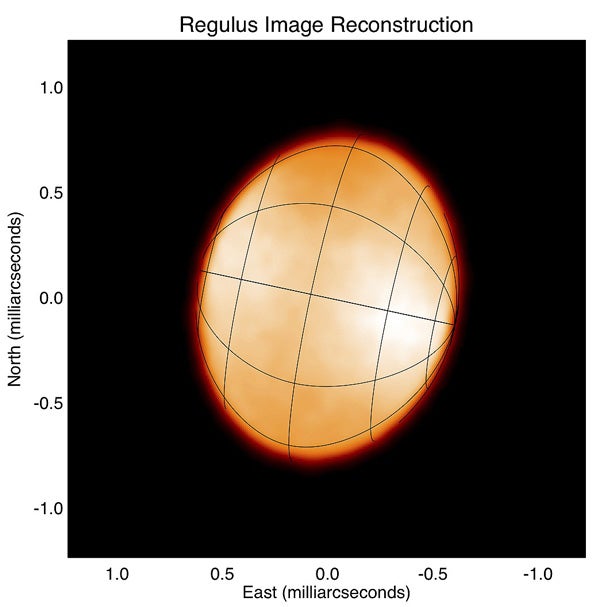The von Zeipel law, named for its creator Swedish astronomer Edvard Hugo von Zeipel, has been used for the better part of a century to predict the difference in surface gravity, brightness, and temperature between a rapidly rotating star’s poles and its equator.
Using a technique called interferometry, the researchers essentially zoomed in to take close-up pictures and measurements of the winter star Regulus. It’s the brightest star in the constellation Leo, and if it were spinning just a few percent faster, it would fly apart.
The astronomers found that the actual difference in temperature between its equator and poles is much less than the old theory predicts.
“Our model fitting of interferometry data shows that while the law correctly describes the trend of surface temperature variation, it deviates quantitively,” said Xiao Che from the University of Michigan, Ann Arbor.
“It is surprising to me that von Zeipel’s law has been adopted in astronomy for such a long time with so little solid observational evidence,” Che said.
It’s important to get this number right, said John Monnier from the University of Michigan.
“In some cases, we found a 5000° Fahrenheit (2760° Celsius) difference between what the theory predicts and what our actual measurements show,”
Monnier said. “That has a big effect on total luminosity. If we don’t take this into account, we get the star’s mass and age and total energy output wrong.”
Monnier led the creation of the Michigan Infra-Red Combiner (MIRC) instrument that was used to take the measurements that led to this discovery. MIRC uses interferometry to combine the light entering four telescopes at the CHARA array at Georgia State University so that it seems to be coming through a device 100 times larger than the Hubble Space Telescope. The technique lets astronomers see the shape and surface characteristics of stars. Previously, stars were mere points of light even with the largest telescopes. In this case, zooming in on Regulus let the researchers measure its poles and equator temperatures separately. “Normally, you would just be able to get an average temperature,” Monnier said.
So where did von Zeipel go wrong? Monnier believes his predecessor didn’t take into account circulation on stars that’s not unlike wind patterns on Earth.
“The Earth has a hot equator and cold poles and that causes air circulation,” Monnier said. “The hot air wants to flow toward the poles and equilibrate, bringing the temperatures closer together. This is a source of some weather patterns on Earth.”
The von Zeipel law, named for its creator Swedish astronomer Edvard Hugo von Zeipel, has been used for the better part of a century to predict the difference in surface gravity, brightness, and temperature between a rapidly rotating star’s poles and its equator.
Using a technique called interferometry, the researchers essentially zoomed in to take close-up pictures and measurements of the winter star Regulus. It’s the brightest star in the constellation Leo, and if it were spinning just a few percent faster, it would fly apart.
The astronomers found that the actual difference in temperature between its equator and poles is much less than the old theory predicts.
“Our model fitting of interferometry data shows that while the law correctly describes the trend of surface temperature variation, it deviates quantitively,” said Xiao Che from the University of Michigan, Ann Arbor.
“It is surprising to me that von Zeipel’s law has been adopted in astronomy for such a long time with so little solid observational evidence,” Che said.
It’s important to get this number right, said John Monnier from the University of Michigan.
“In some cases, we found a 5000° Fahrenheit (2760° Celsius) difference between what the theory predicts and what our actual measurements show,”
Monnier said. “That has a big effect on total luminosity. If we don’t take this into account, we get the star’s mass and age and total energy output wrong.”
Monnier led the creation of the Michigan Infra-Red Combiner (MIRC) instrument that was used to take the measurements that led to this discovery. MIRC uses interferometry to combine the light entering four telescopes at the CHARA array at Georgia State University so that it seems to be coming through a device 100 times larger than the Hubble Space Telescope. The technique lets astronomers see the shape and surface characteristics of stars. Previously, stars were mere points of light even with the largest telescopes. In this case, zooming in on Regulus let the researchers measure its poles and equator temperatures separately. “Normally, you would just be able to get an average temperature,” Monnier said.
So where did von Zeipel go wrong? Monnier believes his predecessor didn’t take into account circulation on stars that’s not unlike wind patterns on Earth.
“The Earth has a hot equator and cold poles and that causes air circulation,” Monnier said. “The hot air wants to flow toward the poles and equilibrate, bringing the temperatures closer together. This is a source of some weather patterns on Earth.”










